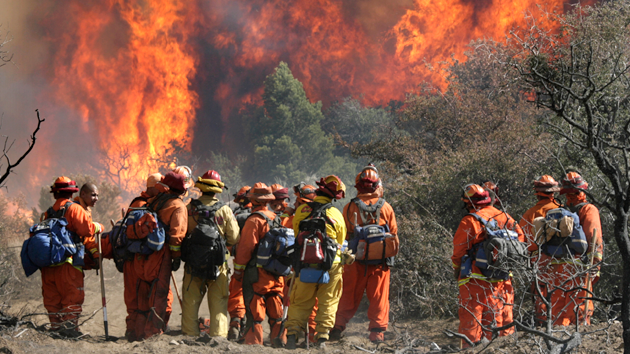Image From Mother Jones
California’s massive wildfires have burned more than 1 million acres this year, destroying hundreds of homes and killing over a dozen firefighters and civilians. On the front lines against the flames are state inmate “volunteers,” earning $1 an hour to dig containment lines often just a few feet away from the fires, sometimes armed with nothing more than a shovel.
“When you hear that a fire has been 50% or 100% contained, that’s inmate firefighters doing the job,” said Bill Sessa, a spokesman for the Department of Corrections and Rehabilitation (CDCR). “These people are in the front line because their job is to get ahead of the fire. Our crews are quite often put between the homes and the fire trying to cut containment lines.”
The reader might conclude that this is a poorly disguised form of modern-day slavery. Not according to the CDCR. “If you look at it from the inmate’s perspective, it’s difficult to call them enslaved when they’re volunteering to do the job,” said Sessa, who extols the virtues of the fire camp program. “The camps are a different and more welcoming environment than a prison,” he said. “The food is better, and they are the highest-paying job a prison inmate can have. Most also will tell you that they appreciate the opportunity to do something constructive during their time in prison and perhaps pay back the community for the crime they committed. They are there because they chose it as a coveted position. They feel a sense of pride in doing what they do.”
A “coveted position” risking their lives while in captivity? Earning less than a tenth of the wages earned by their lowest-paid civilian counterparts? With no protection under workers’ compensation, occupational health or safety laws? One has to marvel at the audacity of the claim.
It is true that wages in the fire camp program, while outrageously low compared to outside standards, are much higher than wages earned by other prisoners. California’s inmates typically earn from 8 cents to 95 cents an hour. Inmate firefighters, however, can make up to $2.56 a day in camp and $1 an hour.
By many reports, the food is also better, and the camps offer more space than prisons, in a natural environment. In addition, time spent at the fire camps earns inmates credit toward early parole and gives them the chance to see their families more often.
Considering the living conditions in state prisons, which are at the very least hard to bear, when not outright intolerable, it can hardly be said that the prisoners who are offered this possibility have much of a choice. And the “benefits” offered by the program certainly come at a steep price. Inmate firefighters are assigned to the most dangerous tasks, as they are specifically trained to cut fire breaks to stop or redirect advancing flames.
They receive only two weeks of training, compared to the three-year apprenticeships of full-time civilian firefighters, after which they will often work 24 hours straight, sometimes even 72, containing the blazes at great personal risk. And if they are injured or killed on the job, the chance of compensation for them or their families is remote.
“Your feet are hot and tired, and they have a pulse of their own,” said Marquet Jones, an inmate at Rainbow Camp, one of the three all-female fire camps in California. “You feel like you can’t breathe, but you’re breathing. Your face feels like it’s about to melt off, but it’s there. You have to be aware of everything. Otherwise, you’re not going to survive.” In the last year, three inmates have died in the line of duty: 26-year-old Matthew Beck was crushed by a falling tree in May 2017; 22-year-old Frank Anaya was fatally wounded by a chainsaw in July 2017; and 33-year-old Anthony Colacino died in April after he collapsed during a training hike.
The CDCR denies that the primary focus of the program is the value provided to the state by extremely cheap labor. “Our primary mission as a corrections system or a department is to provide inmates with skills to improve their lives when they leave,” said Sessa. Most, however, will find it impossible to find a job in the field once the shackles come off.
Some fire departments in the state have an outright ban on hiring workers with a felony conviction, but most will be denied employment because they cannot be certified as emergency medical technicians (EMTs), under a 2008 law that establishes mandatory prohibitions on certain criminal records.
“If the goal were to develop these skills, they would help them turn their training into real careers, but there’s a disconnect,” said a former inmate who served in the Puerta La Cruz fire camp from 2004 to 2005. According to information that was recently removed from the CDCR’s website, “In an average year, the Conservation Camp program provides approximately three million person-hours responding to fires and other emergencies and seven million person-hours in community service projects, saving California taxpayers approximately $100 million.” The “primary mission” of the program is quite obvious and inmate well-being and “self-improvement” are most certainly not a part of it.
A Long History of Exploitation
While inmate labor in California dates back to the mid-19th century, when prisoners were used to build the state’s first permanent prison, the inmate firefighting programs began in the 1940s, when the state began to replace men assisting in the war effort with part of the incarcerated population. Forty-one “interim camps” were set up during World War II, and these formed the foundation of the network of permanent camps that the state would later operate.
In 1946, under Gov. Earl Warren’s Prisoner Rehabilitation Act, California opened its first permanent fire camp under the joint supervision of the state’s Division of Forestry and the California Department of Corrections. The number of camps grew steadily in the 1940s and 1950s, and they saved the state so much money that by 1959, Gov. Edmund G. Brown promised to double the program’s size. At their peak in 1967 (in terms of the proportion of prisoners in fire camps), they held about 8.5% of the total prison population. Although the relative inmate population in the camps later declined, California increased the number of its camps in the 1980s, as incarceration rates soared with political leaders vowing to “get tough” on drugs and crime.
Today, the CDCR operates 44 fire camps in 27 counties, in cooperation with the California Department of Forestry and Fire Protection (CAL FIRE) and the Los Angeles County Fire Department (LAC FIRE). In all, the camps house about 3,800 inmates, making up 13% of California’s firefighting force.
But in recent years California has been taking steps toward reducing its prison population, as voters have pushed for a series of criminal-justice reforms to release thousands of inmates from prisons or redirect them to county jails. As a result, the number of low-security inmates has dropped dramatically in state prisons—precisely the population from which the CDCR recruits its firefighters. At a time when the risk of wildfires is steadily increasing because of global warming, state officials have been arguing against the shrinking number of inmates.
In 2014, when the issue of overcrowded prisons was being debated in state courts, lawyers for the state attorney general’s office sparked public outrage by claiming that extending early-parole credits to minimum-custody inmates would “severely impact fire-camp participation—a dangerous outcome while California is in the middle of a difficult fire season and severe drought.”
Corrections officials are now working harder than ever to recruit new inmates for the program by making more prisoners aware, according to Sessa, of the “many advantages” that can “benefit [them] immediately if they choose to volunteer.” CAL FIRE spokesman Scott Mclean has said the agency is “working closely with CDCR in keeping [fire-camp] numbers up” by helping “entice other inmates to join the ranks.”
In the coercive and often violent environment of the state prison system, many inmates may find themselves under heightened pressure to sign up for the program as a result of these efforts.
But it takes no great stretch of the imagination to understand just how “voluntary” this decision must feel to prisoners eager to escape intolerable prison conditions, to cut time from their sentences or to see their families. “It’s a cruel joke,” said Deirdre Wilson, a former inmate who said she signed up for the fire program because she was desperate to return to her children. “You’re volunteering to put your life on the line, but you’re not really volunteering.”











